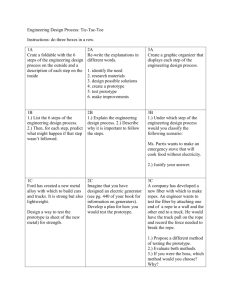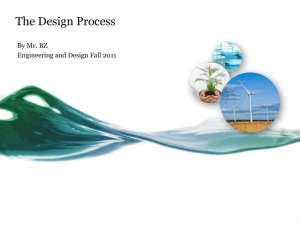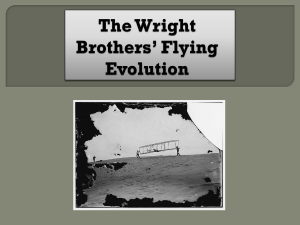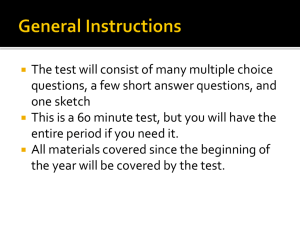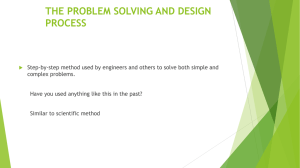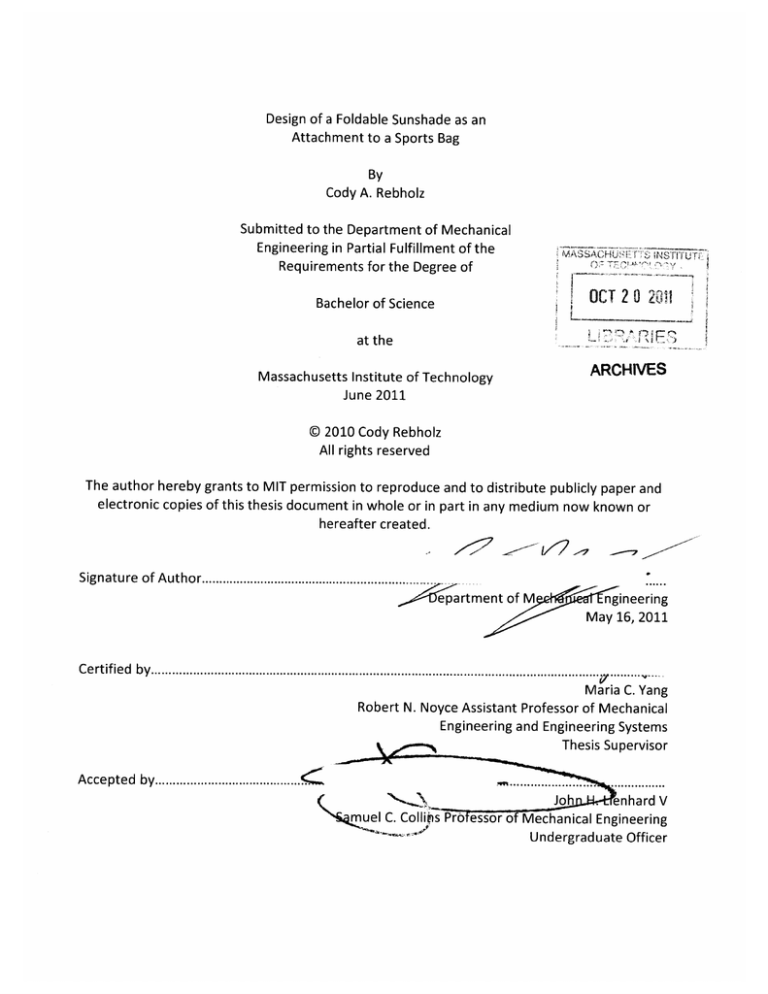
Design of a Foldable Sunshade as an
Attachment to a Sports Bag
By
Cody A. Rebholz
Submitted to the Department of Mechanical
Engineering in Partial Fulfillment of the
Requirements for the Degree of
MASACUV
.T
OCT 2 0 2011
Bachelor of Science
at the
ARCHIVES
Massachusetts Institute of Technology
June 2011
@ 2010 Cody Rebholz
All rights reserved
The author hereby grants to MIT permission to reproduce and to distribute publicly paper and
electronic copies of this thesis document in whole or in part in any medium now known or
hereafter created.
Signature of Author........................................................
bpartment of M
ngineering
May 16, 2011
Certified by............................................................................................
..
Maria C.Yang
Robert N. Noyce Assistant Professor of Mechanical
Engineering and Engineering Systems
Thesis Supervisor
Accepted by..........................................
YU
.
.
.
.
.
.
.
.
. . ..
. ..............
Joh
. enhard V
muel C.Collits Pro essor of Mechanical Engineering
Undergraduate Officer
Design of a Foldable Sunshade as an
Attachment to a Sports Bag
By
Cody A. Rebholz
Submitted to the Department of Mechanical Engineering on
May 16, 2011 in Partial Fulfillment of the Requirements for the
Degree of Bachelor of Science in Mechanical Engineering
ABSTRACT
The purpose of this project was to design a foldable, lightweight, inexpensive addition to an
existing duffel bag that will provide enough shade to cover the user's head and upper torso.
The intended user for this product is an athlete who plays the sport of Ultimate Frisbee, as this
typically involves bye rounds which some use for napping on the sidelines. The existing
products to fill this need are too expensive, heavy, bulky or uncomfortable. The process for
designing this feature included an extensive ideation phase, potential user interviews,
prototype mock-ups, and the production of a final working prototype. This final prototype is
made with the roll-out mat that comes attached to the Under Armour Medium Team Duffel bag
and the metal support hoops from a collapsible laundry hamper. This prototype meets all of
the product specifications that were based on the requirements of the interviewed users.
Thesis Supervisor: Maria C.Yang
Title: Robert N. Noyce Assistant Professor of Mechanical Engineering and Engineering Systems
TABLE OF CONTENTS
INTRODUCTION......................................................................................................7
INTENDED USER.........................................................................................................8
PRODUCT SPECIFICATIONS ........................................................................................
9
IDEATION TI ...............................................................................................................
10
DESIGN EXPLORATION ........................................................................................
11
USER FEEDBACK
QQ..................QQ.............................................................................15
FUTURE EXPLORATION .........................................................................................
16
APPENDIX........................................
18
................................................................
TABLE OF FIGURES
8
FIGURE 1: THE EUREKA SOLAR SHADE. .........................................................................................................................
FIGURE
FIGURE
FIGURE
2: SAMPLE OF FOUR SKETCHES FROM THE IDEATION PROCESS. ....................................................................
3: FOLDABLE LAUNDRY HAMPER USED FOR SUPPORT OF THE SUNSHADE.....................................................12
4: TESTING OF THE INITIAL PROTOTYPE WHICH USES THREE SIDES OF THE HAMPER FOR SUPPORT..................12
11
FIGURE 5: M OCK-UP PROTOTYPE OF ONE-POLE DESIGN.......................................................
.......
................... 13
FIGURE 6: PATTERN OF CIRCULAR SLEEVES SEWN INTO ROLL-OUT MATS TO HOUSE THE SUPPORTS. .........................
14
FIGURE 7: COM PLETED FINAL PROTOTYPE....................................................................................................................14
FIGURE 8: PHOTO WALK-THROUGH OF FOLDING AND STOWING PROCESS.....................................................................15
FIGURE 9: D OG USING A SHADE TENT. ..........................................................................................................................
17
FIGURE 10: ADDITIONAL PHOTOS OF THE ONE-POLE DESIGN PROTOTYPE. ....................................................................
18
FIGURE 11: ADDITIONAL PHOTOS OF THE THREE-SIDED PROTOTYPE.
19
FIGURE
12:
...........................................
ADDITIONAL PHOTOS OF THE FINAL PROTOTYPE..........................................
........
19
FIGURE 13: METAL SUPPORT HOOP TAKEN OUT OF FINAL SUNSHADE PROTOTYPE .....................................................
20
FIGURE 14: FINAL PROTOTYPE LAYING FLAT FOR USE AS ORIGINAL ROLL-OUT MAT.
20
..........................
Introduction
In the fall of 2009, as part of an exercise for 2.009, I observed the other players at an
Ultimate Frisbee tournament and came up with an idea. As an Ultimate player, I know that
trying to find a place to lie down out of the sun when you have an hour or so before your next
game can be hard. Many players just lie down on the sideline and cover their head with a
sweatshirt, but this solution leads to a hot head. The purpose of this design project is to add a
sunshade accessory to a duffel bag that can give you just enough shade to keep your head out of
the sun without being too bulky. The proposed accessory can also serve other purposes such as a
mat to sit on while you change your shoes, which is a regular accessory on other sports bags.
The existing products that this sunshade would compete with are generally more
expensive, heavier, bulkier, and separate from the duffel bag that players will be carrying
anyway. The competing products do usually create more shade to cover the whole body or a
whole group of people, and give the user more room to move around, but at the expense of being
another load to carry to the field which can be as large and as heavy as the duffel bag full of the
player's sporting gear. One such product is the Eureka Solar Shade, shown in Figure 1. This
product sells for $109.99 and weighs in at 8 pounds. It packs to a 7 inch radius by 23 inches
long, but covers 58.5 square feet. Other products can range from $40.00 to $400.00 and all of
them seem to weigh at least 6 pounds. No products were found that were comparable to the
proposed sunshade in cost, weight or bulk.
Figure 1: The Eureka Solar Shade. Source: Cabelas.com.
The process of designing this sunshade begins with identifying a need that has not been
filled by other products and a user group that would find the product helpful. Then, before
building any prototypes an extensive ideation process is completed to produce a wide range of
methods to fulfill that need. Next, after compiling a set of product specifications from user
preferences the prototyping process can begin with simple mock-ups to narrow down the ideas
before a final prototype can be made. This prototype can then be used to collect user feedback to
explore improvements for the future.
Intended User
This product is targeted quite specifically to players of the sport of Ultimate Frisbee.
Given that it is a very lightweight and inexpensive addition to an already popular athletic bag, it
could be used by anyone who would normally buy the original duffel bag. However, for the
purposes of this project, this product is intended for the ever-growing number of Ultimate
players who play in weekend tournaments with three to five games per day.
At these
tournaments, teams usually have at least one bye round where other teams are playing but they
are not. This break is typically about two hours long, which lends itself to a short nap on the
sidelines.
Certainly anyone who plays outdoor sports might find this feature useful as it can still
function just like the original mat to sit on that comes with the bag. And even if you do not have
an opportunity to take a nap on the sidelines, the sunshade could be used for other purposes such
as covering belongings in wet weather. One of my teammates even suggested using it as a dog
tent, as many Ultimate tournaments allow dogs. So this product could have many other uses and
be marketed to plenty of other groups, but the design process has been focused for Ultimate
players who just need a little shade for a nap on the sidelines.
Product Specifications
I interviewed members of the MIT Men's Ultimate Frisbee team and members of a club
team named Slow White throughout the design process as potential users of this product to find
out what requirements are most important to them. Also, as a member of the intended user group
myself, I added my own preferences and compiled a list of product specifications. Table 1 below
summarizes the product specifications based on potential user input in order of importance.
Table 1: Table of product specifications.
Product Attribute
Lightweight
Portable
Inexpensive
Durable
Comfortable
Specification
Less than 2 pounds added to existing bag.
Fits into existing pocket for roll-out mat.
No more than $10 extra.
No critical wear after 50 hours of use.
At least 4 inches clearance above face and 24 inches wide at shoulders.
Ideation
The only current products designed specifically to fulfill this need are the sunshades
discussed in the introduction and larger or more permanent shade tents or pavilions.
Other
products that can be used for this purpose are tents designed for camping or sweatshirts, towels
or hats covering your face. The tents for camping tend to be unbearably hot when set up in the
sun as well as being bulky. Covering your face with an article of clothing is easy and adds no
weight as you would be carrying it anyway, but that also leaves you no ventilation for your head.
In the ideation process, I focused specifically on attachments to the existing duffel bag to reduce
the number of items a player needs to carry to the field, and the ventilation and ease of breathing
was a major concern.
In the ideation process, 20 ideas for making the sunshade were produced before they
were narrowed down. All of these ideas consisted of attachments to the existing duffel bag, and
many used the existing roll-out mat on the Under Armour bag for ease of construction, but not to
the extent of confining the creative process. A sample of four of these ideas is presented in
Figure 2 below.
~ 10
Figure 2: Sample of four sketches from the ideation process.
Design Exploration
All of the ideas that were generated in the ideation process required some sort of pole for
support. The mock-up process which is used to narrow down the ideas began with the testing of
tent poles. Modem dome tents use flexible poles that make an arc from one corner of the base to
the opposite corner and hold up the tent in the middle. I thought these poles would be useful for
this product, but unfortunately they are too stiff to make a reasonable arc for such a small
product. After searching for thinner, more flexible poles I came across the idea of using the
metal support hoops of a foldable laundry hamper such as the one pictured in figure 3 below.
Figure 3: Foldable laundry hamper used for support of the sunshade. Source:
Dinodirect.com
After narrowing it down to two ideas for utilizing the laundry hamper supports, two
prototypes were made to explore these possibilities.
These rough prototypes are pictured in
figures 4 and 5 below. The first uses three sides of the hamper and mostly encloses the user.
The second uses just one of the metal supports that is threaded through a sleeve on the end of the
mat and stuck in the ground at both ends. The prototype in figure 4 is more rigidly supported
and the enclosed side ensures that it will block the sun regardless of the angle, whereas the
prototype in figure 5 allows for more ventilation but at the cost of rigidity.
Figure 4: Testing of the initial prototype which uses three sides of the hamper for
support.
Figure 5: Mock-up prototype of one-pole design.
Based on feedback from users and the advantages of rigidity and convenience of packing
(as it does not split into two parts) the prototype from figure 4 was selected to be improved upon
as the final prototype. The metal support hoops were removed from the hamper and another rollout mat was removed from an identical bag. This second roll-out mat was professionally sewn
onto the back of the existing mat in a pattern to form sleeves for the rings to be threaded through.
This pattern is shown in figure 6. The metal rings needed to be shortened slightly to fit into the
sleeves, but everything came together and the final working prototype can be found in figure 7.
And as required by the product specifications, this final prototype folds up into the original
sleeve as shown in the sequence of pictures in figure 8, and adds no noticeable weight or size to
the bag.
Figure 6: Pattern of circular sleeves sewn into roll-out mats to house the supports.
Figure 7: Completed final prototype.
Figure 8: Photo walk-through of folding and stowing process.
User Feedback
In talking to users there was a lot of positive feedback and plenty of new ideas, mostly for
different uses for the product. Of those that responded to my survey of the two Ultimate teams,
there was much interest in the product at the price point between $5 and $10 above the original
price of the bag. Everyone had their own order of importance for different product attributes, but
generally lightweight, portable/foldable and inexpensive topped their lists with sturdiness
following close behind. Allowing for more airflow and ventilation was also suggested multiple
times. Aesthetics are still to be considered as an important attribute, but not at the cost of
functionality and price.
Some new ideas which sprang from the user interviews were very interesting, but most of
them revolved around different ways to use the existing product rather than fundamentally
different ways of making the product. For example, one idea was to make it waterproof. This
~15 ~
would still not make for a comfortable nap in the rain because your lower body would not be
covered, but it would be great for keeping sweatshirts and pants dry when you take them off to
go play. Also, this waterproof sunshade could be made slightly larger so it could be folded over
and completely cover the bag to keep the bag itself dry. Another great idea that sprang from
conversations with potential users was to market this product to dog owners as well. More
precisely, a bag could be designed just for dog owners with specific places for bowls, food,
treats, water, toys, leashes and anything else they might need and it could have a small sunshade
tent attached specifically for use by the dog.
Future Exploration
Going forward, this product could be improved in a number of ways. The first suggested
improvement would be to make the sunshade larger to give more room to move around
underneath. The fabric could also be extended beyond the support structure to tuck under the
user so they do not have to lie directly on the ground. This also ties into the need for the outer
edge to be held in place in some manner, because the weight of the full bag generally keeps it in
place, but the other side of the sunshade can move around too easily. This could be solved in a
number of ways, such as staking it into the ground or using another strap or a pole to attach it to
the duffel bag underneath the user.
Another issue is the tendency for the apex to occasionally invert and fall onto the users
face. It does not happen often and is not terribly discomforting when it does, but it happens more
frequently in the wind and it is annoying enough to necessitate a solution. The easy solution
would be to add another small pole, but this adds weight and complexity. Perhaps the use of
stakes could solve the issue, or simply changing the geometry of the product, but this is an area
that requires more development.
The versatility of this product has been another suggested area for improvement, as some
people would like a more open shade tent for ventilation on a hot summer day, and an enclosed
tent on a cold and windy day to stay warm. Perhaps this could be addressed by poles that raise
the end of the support structure up off the ground on a hot day. Otherwise, the side could be
made of mesh with a zippered cover to allow you to open and close it much like a tent window.
Finally, alternate uses for this product should be considered to increase the utility of the
product. The use of this product by dog owners could be expanded by including water and food
containers, and there is already a market for this type of product as evidenced by Figure 9 below.
I also particularly like the idea of making it waterproof and trying to utilize it as a cover for the
original bag. This way the product is useful in all weather situations. In all, this product has the
potential for many uses by many different groups of people.
Figure 9: Dog using a shade tent. Source: Amazon.com.
~ 17 ~
Appendix
Figure 10: Additional photos of the one-pole design prototype.
Figure 11: Additional photos of the three-sided prototype.
Figure 12: Additional photos of the final prototype.
Figure 13: Metal support hoop taken out of final sunshade prototype
Figure 14: Final prototype laying flat for use as original roll-out mat.
~ 20 ~

